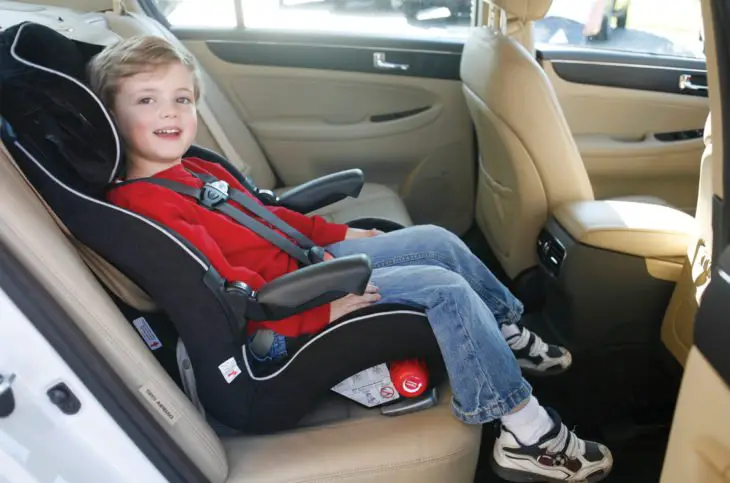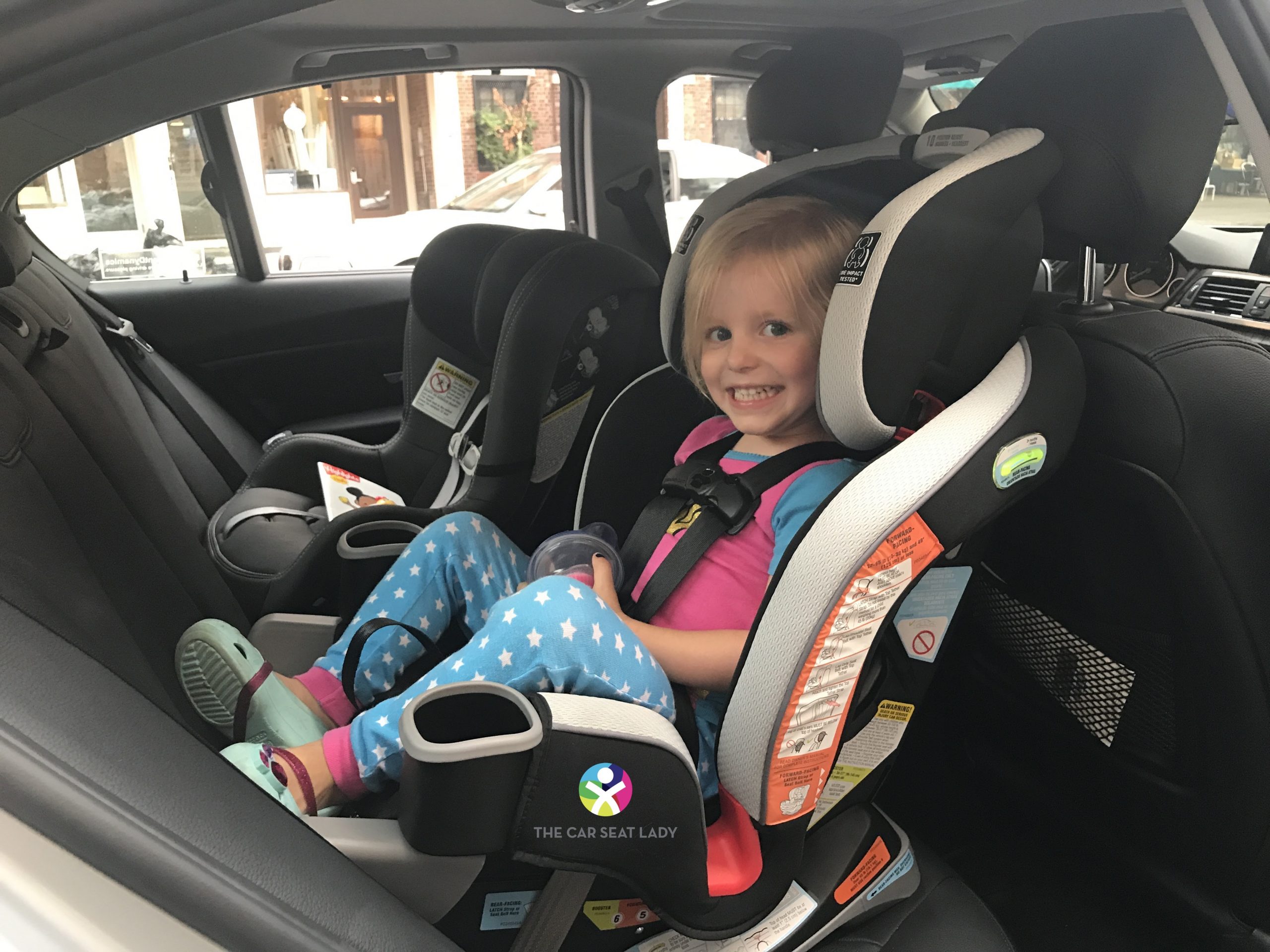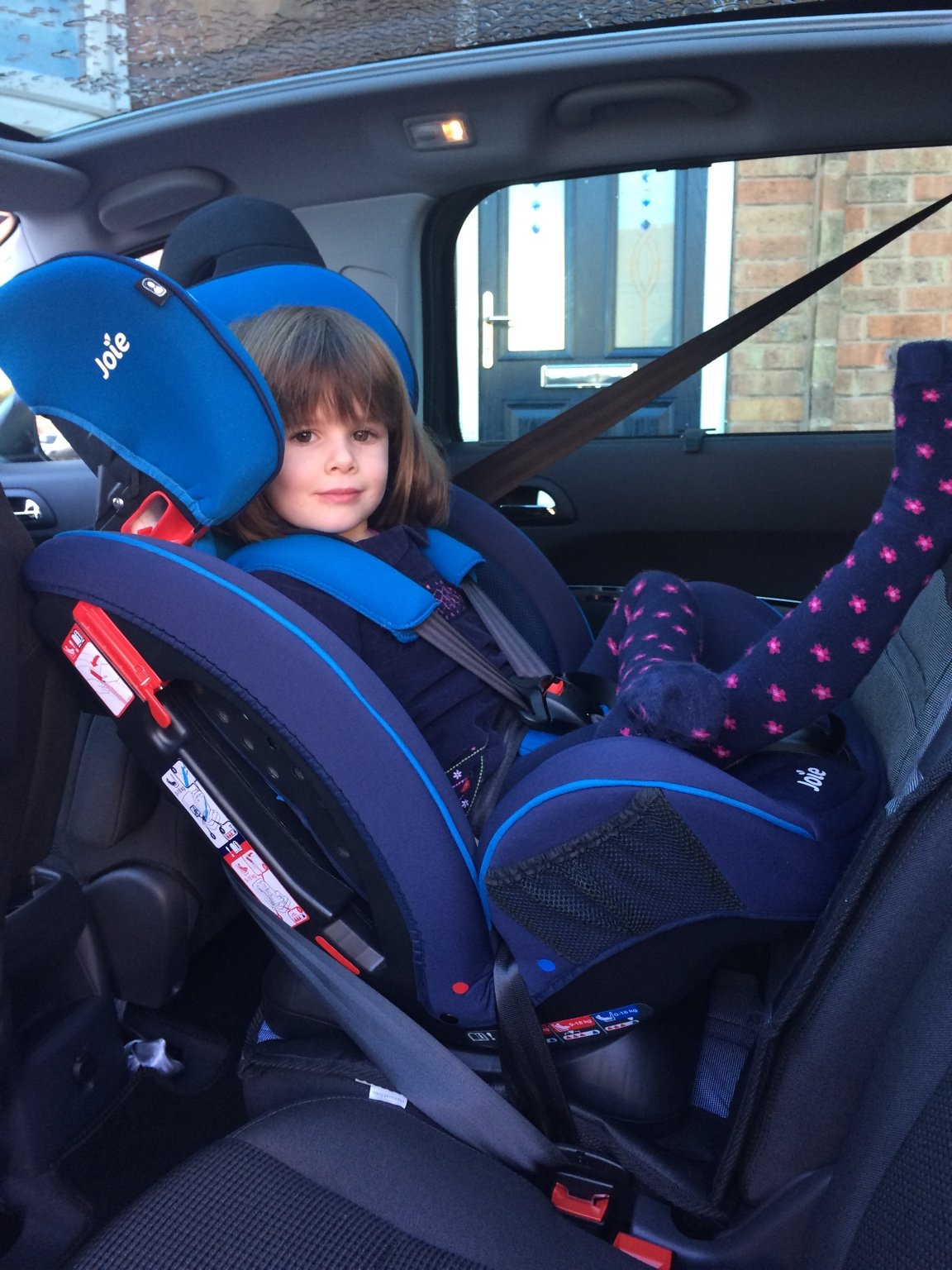What About Off The Charts Big Kids
A 95th percentile child may look stronger than his 5th percentile friend, but in a crash the bigger child is MORE at risk if hes riding forward-facing. The rigidity of bones and the strength of ligaments in the spine is likely the same in children of the same age, no matter their size. And a 95th percentile baby likely has a much larger, heavier head, which will pull forward which much more force than that of a 5th percentile child.
Convertibles with high height and weight limits, enabling rear-facing for as long as possible
When Can You Turn The Car Seat Forward Graco
When the child is over 40 pounds and at least four years old. The car seat has been designed with a forward-facing weight limit of 65 lbs, but their height limit for harnessing up to 57 inches tall.
If your older children are above this height range you should consider moving them into a booster seat or other type of belt-positioning device.
Wont Their Legs Be Uncomfortable
The thing is, you may imagine your childs legs are squished in a rear-facing position. However, children are flexible, and this is the safest position for their legs. If your car crashes, forward-facing kids are at a much greater risk all around.
If they complain about the leg room, take a break and let them stretch. They may also enjoy crossing their legs or hanging them over the sides.
Don’t Miss: How Long Will My Car Last
What Other Rules Are There About Kids In Child Restraints
In NSW, it says children must kept in an approved restraint until they are four years old.
Obviously the first thing to remember is that proper installation is vital. Far too many people guess at how to install a seat, or a harness, and rear-facing seats in particular can be tricky. Get yours checked, or better yet installed, by an expert.
Specifically, in NSW, it says children must kept in an approved restraint until they are four years old. Children aged between 6 months and 4 years must be restrained in an approved rearward or forward-facing restraint. Once your child has outgrown their rearward-facing restraint they can be moved into a forward-facing restraint.
Its an interesting point about what age they might grow out of the rear-facing, baby-capsule-style child seat, but that doesnt mean you cant get a rear-facing one thats made for larger children.
Read More: How to choose the right car to suit three child seats
The next stage, in Victoria, NSW, everywhere in Australia, is from four to seven years, when, as VicRoads puts it, they must travel in a forward facing child restraint or a booster seat.
Children aged 7 years and older can use a child restraint, or an adult seatbelt, depending on their size.
I Already Turned My Kid Forward

Yes! When we know better, we must do better. A few months ago when you turned her forward facing you did what you thought was best, but now you know differently. Avoid regrets, and give your child the best protection.
Many parents worry that it will be a disaster turning an older child back rear-facing. Here is one moms experience turning her almost-3-year-old son back rear-facing:
I was initially very hesitant to move my almost three year old son to rear facing from forward facing. He has been sitting forward facing for over a year and can be strong willed when it comes to change. However, after hearing how much safer it is I was willing to try. The first three or so drives were very difficult as he asked to look out mama and dadas window almost the entire time. We ignored and distracted and I was about to give up when I noticed that although he still complained about sitting rear facing it happened less and less. Now he asks maybe once every other drive if he can sit forward facing and was even fine the other day when his friend joined us and sat forward facing. It was a tough first few drives, but I am very happy we did it and I feel so much safer.
Don’t Miss: Will Carvana Buy My Leased Car
How Much Should A Baby Weigh To Face Forward In Car Seat 2019
Convertible. Most convertible car seats can be used in the rear- facing position until a child reaches the weight limit, typically 40 to 50 pounds. At that point, the seat can be converted into a forward facing car seat. These seats are larger and designed to stay installed in the vehicle.
When Can I Turn My Baby Around To Face Forward In The Car
Determining when a baby can face forward in the car is an important milestone for parents. According to the American Academy of Pediatrics, children should remain in rear-facing car seats until they turn 2 or have outgrown car seat height and weight limits.1
By signing up, you agree to our Terms and Conditions and Privacy Policy.
You May Like: How Much Horsepower Does My Car Have
When To Move Your Child From A Forward
Even if your provincial or territorial regulations allow the use of a booster seat, children should keep using a forward-facing seat until they outgrow its weight or height limits. Many forward-facing seats have weight limits up to 30 kg .
The harness of a forward-facing seat is designed to fit the narrow shoulders of children. This helps protect children in front, side and rear impact crashes. The harness holds your child back and spreads the forces of a crash over the strongest parts of your child’s body.
Car Seat Safety: When Should Your Child Turn Forward
Celeb mom Kim Kardashian heard a lot of hate feedback when she posted a picture of her 1-year-old son, Saint, buckled into a car seat. What riled everyone up? Hes facing forward in his car seat. Oh no! The law in California State Highway Patrol website states that a child must be age 2 or 40 pounds or 40 inches tall before riding forward-facing in a car seat.
North Carolina law does not specify the age at which a seat can be forward-facing, however the American Academy of Pediatrics recommends that children remain in a rear-facing seat until age 2.
We spoke to Allana Pinkerton, a Global Safety Advocate for diono, a car seat manufacturer, to get the lowdown on why it is considered safer for children under age 2 to remain rear-facing.
When it comes to car crashes, many factors keep children safer and help prevent serious injury. The most vulnerable occupant in a vehicle is a child, especially babies and toddlers who are still developing and whose bones have not yet fused together and are not strong enough to withstand brutal forces. Keeping a child rear-facing as long as possible helps keep them safer in all types of collisions. Pinkerton says.
What if your rear-facing car seat is too small for your growing toddler?
Bottom line? Its safer for your child to remain rear-facing until age 2. If you can make it to birthday No. 3, even better, Pinkerton says. One more year and you are giving your child the optimal protection.
Read Also: How Do I Get My Car Title In Florida
Should I Use A Convertible Seat
Convertible seats are designed to protect kids:
- from birth up to at least 40 pounds facing backward
- up to 65 pounds or even 80 pounds facing forward, depending on the model
Convertible seats are placed in different positions depending on a child’s age and size:
- They face toward the rear until a baby is ready to face forward .
- Then, they can be turned around and “converted” to a forward-facing seat.
Some car seats are known as “all-in-one” or “3-in-one” because they convert from rear-facing to front-facing to booster with the harness removed.
Convertible seats:
The Dreaded Motion Sickness Won’t It Help To Turn Around My Child
The long and short: most kids do not puke less when forward-facing compared to rear-facing.
Weve got lots of information on motion-sickness over here including an explanation of why it is believed to occur, things you can do to decrease the chance of your kid puking, and how to minimize the mess and clean up if your kid does puke.
Also Check: Who Can Get Usaa Auto Insurance
How Do I Know My Child Is Safe In His Rear
There are several things to look for when strapping your child into his or her car seat.
- There should be at least 1 inch of car seat above your childs head. This indicates your child is still within the height limits.
- The harnesses should be at or below your childs shoulders. This keeps your child from sliding out of the seat in case of an accident.
- The harnesses should be snug check to see if you can pinch any of the harness straps between your fingers. If you can, tighten the harness more. A snug harness means less movement of your child in a crash, resulting in less injury.
- The chest clip should be at your childs armpit level. This slows your childs forward movement down in a crash, resulting in less stress on your childs neck and spine.
Did you know three out of four car seats are not used or installed correctly? Our certified car seat technicians are available to answer your safety seat questions. To schedule a car seat installation appointment, , call Sanfords Safety Center at , or email
Should Car Seat Go Behind Driver Or Passenger

For ease of access and keeping an eye on a baby, the most common spot for a babys car seat is the rear passenger side. But the study showed that children under age 3 seated in the center of the back seat had nearly half the risk of injury in motor vehicle crashes than children seated in either of the other positions.
You May Like: How Much Does A Car Salesman Make Per Car
When Can You Turn A Car Seat Forward
Most children can ride forward-facing when they weigh between 20 and 40 pounds and are at least one year of age. Parents should consult their car seats instruction manual for specific recommendations about weight, height, or age.
Be sure to check the date your child outgrows a convertible seat before you buy another size it may not be necessary if he is on the small side.
Also, remember that any rear-facing infant weighing more than 25 pounds needs to move into a front-facing harnessed seat because his head is too heavy for an upright position in a five-point harness . This change usually occurs by 12 months of age but make sure this seat fits your car and uses the LATCH system.
How Much Should A Baby Weigh To Face Forward
You should switch your baby forward facing when they reach the maximum weight for rear-facing with their car seat.
This weight is usually around 22-35 pounds for rear-facing only seats, and 35-40 pounds for convertible seats. For 3-in-1 seats, the limit is usually around 40-50 pounds.
Overall, these weights vary from car seat to car seat. Always check your car seats manual or contact the manufacturer for details about the maximum weight for rear-facing use.
Weight Limit for Rear-Facing Children:
- Usually 22-35 pounds for rear-facing only seats
- In general 35-40 pounds for convertible seats
- Usually 40-50 pounds for 3-in-1 seats
- Check manual or manufacturer for your car seats specifications
Don’t Miss: When Replacing Car Battery Which Terminal First
When Should We Switch To A Toddler Bed
There is no specific recommended age for transitioning to a toddler bed.
Some parents do it as early as 15 months and others not until after 3 years.
Timing often depends on your childs physical skillsyoull want to make the transition to a bed before your intrepid tot masters the art of crib escape..
At What Age Can A Child Use A 3 Point Seat Belt
A child should remain in a rear-facing car seat until the age of two, and then use a forward-facing car seat that is appropriate for their size. When children outgrow this type of car seat its time to move into booster seats because they are designed to be used with adult lap and shoulder belts.
Children can ride without boosters when they have reached at least 145 cm in height or at around 11 years old, whichever comes first. The three-point belt system holds them firmly but does not come across the neck so if there is an accident they will not be injured like adults might experience.
It also keeps them safe from flying through windows which could cause serious accidents while still keeping them attached to the car frame.
You May Like: How Much Does A Car Salesman Make Per Car
Height And Weight Requirements
- Infants should stay in rear-facing seats until they reach one year of age.
- A properly installed tether strap should be present in the forward-facing seat, to keep it in its best working order.
- According to some experts, the baby can be kept in the rear-facing seat even longer. It will mainly depend on how the seat continues to fit the child. For instance, preemies require longer time to catch up in weight and height, so they may stay in these seats longer than usual.
- Once the babies reach the proper weight , and acquire appropriate skills , they can be moved to a front-facing car seat. Babies and toddlers weighing about 20-40 lbs., and between 1-4 years of age, can ride in such convertible seats. These are the basic requirements.
- Children who are too tall for a forward-facing convertible seat , may use a high-backed booster seat. These should also be used by children weighing about 40-80 lbs., and who are 4 years and older. A booster seat raises the kid so that the lap and shoulder belt fit properly. The high back protects the childs head and upper body. Several states like the District of Columbia, California, and Arkansas have made booster seats compulsory.
When To Turn Car Seat Around
It can be difficult to know when to turn a car seat forward, but weight is perhaps the best indicator. You should take a look at your car seats specifications on weight for rear-facing infants and children.
If your child weighs less than the highest weight listed for rear-facing, then you shouldnt switch your car seat forward. If your child weighs more than that upper weight, it may be time to make the switch.
Typically, your child will be around 22-35 pounds when they outgrow a rear-facing only seat. This weight is higher, at 35-40 pounds, for convertible seats. For 3-in-1 seats, the limit is usually around 40-50 pounds.
Always check your specific car seats instructions prior to turning your child forward.
Children should switch forward if their head comes close to the top of the seat. If their head reaches within an inch of the top of the seat, they are at risk of head injury. In a frontal crash, internal parts of the car could hit your childs head. Ideally, your babys head should rest 2 inches below the top of the seat.
Some car seats that have larger height ranges can safely seat children rear-facing over 40 inches! Its essential to monitor your childs growth and their fit in the seat, as well as your car seats guidelines.
Your child should be at least 2 years old before you consider turning the seat forward. According to the AAP, all infants and newborns should ride rear-facing no matter what the circumstances are.
Read Also: How Much Does A Average Car Salesman Make
How Do I Use A Booster Seat
- A booster seat positions your child so that the seat belt fits across the strong bones of the hips and pelvis and not the abdomen, to protect your child from injury.
- While seated in the booster seat, the lap belt should fit low and snug across your childs hips, and not up on their belly.
- The shoulder portion of the seat belt should be positioned over the chest and collarbone, staying between your childs neck and shoulder so that it does not touch the neck.
- Follow the directions for the booster seat to know how to route the seat belt under any armrests or through any belt guides, as directed.
What To Do With Your Old Car Seat

You May Like: How Do You Make Car Freshies
How Long Should My Child Remain In A Forward
Once your child has graduated to a forward-facing car seat, its recommended they remain in it until they reach the height and weight limit of their seat. This can be quite some time as forward-facing car seats can hold anywhere from 60 to 100 pounds depending on the model!
Its important to also keep in mind that even after your child has outgrown their forward-facing car seat, they should still use a booster seat to ensure your cars seat belt system fits them properly.
Children arent ready to use the seatbelt alone until theyre around
At What Age And Weight Does Florida Law State That A Child Can Move From A Rear Facing To Forward Facing Car Seat
four feet, nine inches tall
Use a rearfacing child carseat in the back seat until your child outgrows the weight and height limit of the child car seat. Normally when children are older than one year and weigh more than 20 pounds, you can switch to a forwardfacing car seat in the back of the car.
Read Also: How To Make Car Freshies
